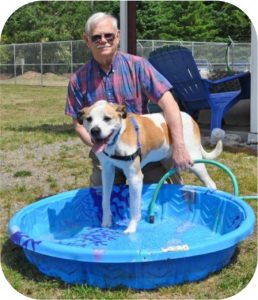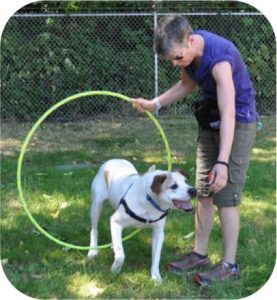Remi’s Lessons
Separation Anxiety and Socialization
I’ve learned something from every dog I’ve known.
Sometimes the lesson is the “Really?” I never knew that” kind of lesson, but often the lesson learned is a validation of what I already knew to be true. Some lessons taught by dogs are so important they deserve to be revisited from time to time. And that’s what I’m doing this week.
My teacher, in this case, was a nine year-old shelter dog named Remi. Remi was handsome. He had a great smile. He loved people. He had separation anxiety. He was very selective about how he related to other dogs.
Remi’s history made it very challenging to adopt him: When Remi first came to the shelter his person said he loved to go to the dog parks, but did suffer from separation anxiety. That person moved and Remi ended up at the shelter. He was adopted but returned after several months due to severe separation anxiety because when he was alone, his behavior was destructive in his home. He was adopted out again and returned after a couple of days because he jumped through a second story window when his people left him. Supposedly he lived with a cat successfully in the first home, but he didn’t interact positively with the cat in his last home. During the time he was at the shelter he did like some of the dogs there, but he was very selective. Separation anxiety and inconsistent socialization clearly were issues before Remi became a shelter dog.
You might think that a shelter is an excellent place to help a dog with separation anxiety because there are so many people there as well as other dogs, but even though a shelter is a safe haven for dogs in transition, an animal shelter is a stressful artificial environment. Regardless of the reason a dog finds himself at the shelter, he’s homeless. It doesn’t matter whether the dog is a “stray” or a dog that has been surrendered by his family. The bottom line is the same: no one wants the dog and he ends up living in a cage. I know… the PC term is “kennel” but an enclosed space with bars is a cage no matter how you dress it up. Think about how awful being in such an enclosed space would be for a dog that suffers from separation anxiety. Shelter dogs don’t sit around swapping stories and commiserating with each other. Each dog is trying to hold it together and very rarely is there energy for helping other dogs. On top of that, if the dog suffers from separation anxiety and is inconsistently socialized like Remi, the shelter experience is even worse. It’s noisy. There are lots of dogs barking. It’s not like a home situation where someone is with the dog most of the time. It’s not a restful environment under any circumstances.
There is no conclusive evidence showing exactly why dogs develop separation anxiety, but far more dogs that have been adopted from shelters have this disorder than those living with a single family since puppyhood so it is believed that loss of an important person or group of people in a dog’s life can lead to separation anxiety. Other less dramatic changes can also trigger the disorder.
Back to Remi. Remi spent six months in a shelter because no one adopted him. His separation anxiety and selective dog interaction were red flags that symbolically waved above his kennel and kept him there.
Remi was charming, enthusiastic, and happy to be with anyone who spent time with him. Shelter staff never gave up on him. They worked hard to help Remi by getting him out of his enclosed space as much as possible; he spent time in the main office and the offices of other staff members. Photos and videos were taken of him, volunteers walked with him, played with him, and loved him. But there are 24 hours in a day and the hours from closing until the next morning were long and lonely.
Ok, so you’re reading this and thinking: “What does this have to do with me?” Here’s the thing. I know you never ever think your dog(s) will end up in a shelter, but unless you plan ahead (See the blog I wrote last March) it could happen. Or, if you’re unable to care for your dog and you haven’t taken the time to socialize him or work on separation anxiety issues, what will happen if your dog goes to live with other dogs in another home? What will happen if your dog’s new people are gone for any length of time? I’ve seen this situation many times and in many instances the dog ends up in a shelter. And there he sits with an “Adopt as an Only Dog-Has Separation Anxiety” note in his file. Many people who go to a shelter to adopt a dog aren’t home all the time and they may have other dogs at home.
If separation anxiety and socialization are issues with your dog it’s never too late to work on the problems. Ideally, this effort should take place in a dog’s early years, but many of you reading this have dogs that are well beyond the puppy stage and you live with other dogs. I don’t want to go into detail here about things you could do to help with separation anxiety and socialization, but all you have to do is look online and you’ll find many really good suggestions. Talk to your vet. Talk with people who are experiencing the same problems. My point is that you need to do something. In the best interests of your dog. In Remi’s memory.
You get the point by now.
I’d like to be able to tell you that after six months in the shelter Remi was finally adopted to a forever home, but it never happened. Remi developed serious medical issues (perhaps dormant for several months) that couldn’t be fixed and he began to decline with no hope of improvement. In his best interests he was gently released from his failing body so he could move on to his next expression of spirit. When he left, Remi was surrounded by his friends at the shelter who hugged him, talked to him and shed tears for him because he never got to experience the life here that we all wanted for him.
Thank you for the important lessons, Remi.








